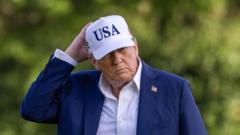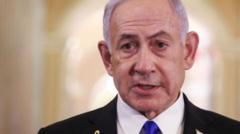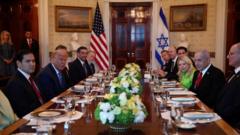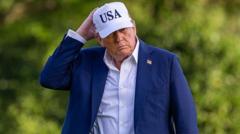The Trump administration has extended the deadline for tariffs while struggling to finalize trade agreements, raising questions about strategic choices in international economics.
Trump's Tariff Delay: A Strategic Move or a Game of Chicken?

Trump's Tariff Delay: A Strategic Move or a Game of Chicken?
Increasing tensions as the U.S. postpones trade tariff implementations amid global economic shifts.
In a surprising turn of events, the Trump administration has opted to delay the implementation of tariffs that were initially heralded as part of a bold U.S. trade strategy. The promise of "90 deals in 90 days" seems increasingly unachievable, as the deadline for tariffs has been pushed from Wednesday to 1 August, with further postponements likely on the horizon. This maneuvering suggests not only an acknowledgment of the complexities of global trade but also a more cautious approach in negotiating with key trading partners.
Treasury Secretary Scott Bessent has indicated that the White House is concentrating on 18 nations that comprise a staggering 95% of the U.S. trade deficit. Yet, the flurry of letters sent this week to various countries reflects frustration more than progress. This communication seems like a revival of a previously unsuccessful strategy, intended to challenge nations rather than promote constructive dialogue.
The chilling effect on markets from earlier tariff advances appears to have lessened, reinforcing a belief in a pattern of delays dubbed TACO – "Trump Always Chickens Out." This perception could contribute to resistance from global partners to reaching agreements that might reduce trade tensions.
Notably, both Japan and South Korea have expressed displeasure with how negotiations are unfolding, with Japan hinting at using its substantial ownership of U.S. debt as leverage in future discussions. The consistent stance from various countries illustrates a collective realization: while America may seek to isolate itself through its tariff policies, the global economy is adapting, and other nations are starting to strengthen bilateral agreements.
As for the impact on U.S. imports and exports, the landscape is shifting dramatically. Recent data indicates a 9.7% decline in Chinese exports to the U.S. while China has successfully increased shipments to other global markets, showcasing a notable 18.9% rise in exports to Africa. In parallel, U.S. revenues from tariffs have surged, marking record receipts in May.
With the effective tariff rate set to hover around 15%, a marked increase from historical averages, the looming uncertainties about the long-term implications of these tariff strategies are sparking anxiety within markets. While the administration moves to solidify its tariff walls, wider economic reconfigurations appear inevitable, as other countries pivot to bolster their trade relations. Observers await how this complex narrative will unfold in the coming months.




















